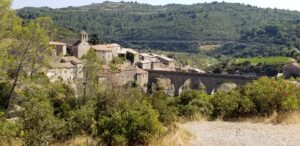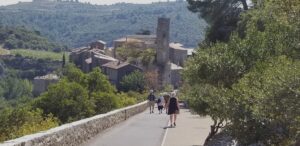Did you ever have a Minervoix wine? If you did but it was long ago, you probably haven’t tried them again because what you had was rough and acidic. We urge you to give another try to these wines from the southwest of France; they have been remarkably improved since that time.
And should you ever find yourself in the French southwest, you would value a trip to the tiny village of Minerve. To appreciate it you need to know a little history.
The village is named after the Roman goddess Minerva, whose cult rivaled Christianity in Imperial Rome. In the Middle Ages, there arose in the southwest a new religion, Catharism, that was opposed to the Catholic Church. This led to war with the Pope and the King of France, which resulted in the extermination of the Cathars. 140 of them in Minerve were burnt at the stake rather than repent their religion. Today, the principal street in Minerve is the Rue des Martyrs.
The gruesome events of the year 1210 left Minerve frozen in time. While we have no reason to doubt that the people of the village practice Catholicism today, a great deal of their livelihoods come from tourists who are aware of their association with the Cathars. In the gift shops, of which there are many, they sell books and ornaments associated with their long-dead Cathar ancestors.
Minerve was carved out of a rock face of a hill overlooking a small river, the Briant. The houses and buildings are made from local stone, with Spanish-style roof tiles. (The entire area was considered a part of Spain until the end of the Thirty Years War in 1649. Spanish cultural influence is still felt strongly throughout the region.) Everything has been cleaned up for the benefit of the tourists. But it is not hard to imagine the medieval lifestyle that must have prevailed there for a very long time.
It is a bit difficult to reach Minerve, but the views as you approach the village are worth the drive. You enter Minerve over a high stone bridge that was built in the early 20th century. How the world got to Minerve, or how the villagers got out, before the bridge was built is hard to imagine. Once across, you have to park just outside Minerve and walk into it. One of the first sights you’ll see is the remains of a tower that was built for defense in the religious war. The little church dates back to the 11th century. Might it have been taken over by the Cathars for their use? Probably. At the bottom of the Rue des Martyrs, you can see the grounds where the brave Cathars lost their lives.
Make sure to leave time for a meal when you visit Minerve. You’ll find genuine French country cooking in the restaurants and cafes there. Most of them are situated with incredible views from the rocky promontory where Minerve sits. We only know what it’s like there in warm weather, so we can say that the local white wines go a long way towards managing the heat.

